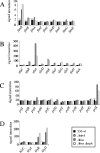Role of histone-like proteins H-NS and StpA in expression of virulence determinants of uropathogenic Escherichia coli
- PMID: 16855232
- PMCID: PMC1540026
- DOI: 10.1128/JB.01956-05
Role of histone-like proteins H-NS and StpA in expression of virulence determinants of uropathogenic Escherichia coli
Abstract
The histone-like protein H-NS is a global regulator in Escherichia coli that has been intensively studied in nonpathogenic strains. However, no comprehensive study on the role of H-NS and its paralogue, StpA, in gene expression in pathogenic E. coli has been carried out so far. Here, we monitored the global effects of H-NS and StpA in a uropathogenic E. coli isolate by using DNA arrays. Expression profiling revealed that more than 500 genes were affected by an hns mutation, whereas no effect of StpA alone was observed. An hns stpA double mutant showed a distinct gene expression pattern that differed in large part from that of the hns single mutant. This suggests a direct interaction between the two paralogues and the existence of distinct regulons of H-NS and an H-NS/StpA heteromeric complex. hns mutation resulted in increased expression of alpha-hemolysin, fimbriae, and iron uptake systems as well as genes involved in stress adaptation. Furthermore, several other putative virulence genes were found to be part of the H-NS regulon. Although the lack of H-NS, either alone or in combination with StpA, has a huge impact on gene expression in pathogenic E. coli strains, its effect on virulence is ambiguous. At a high infection dose, hns mutants trigger more sudden lethality due to their increased acute toxicity in murine urinary tract infection and sepsis models. At a lower infectious dose, however, mutants lacking H-NS are attenuated through their impaired growth rate, which can only partially be compensated for by the higher expression of numerous virulence factors.
Figures






Similar articles
-
YdgT, the Hha paralogue in Escherichia coli, forms heteromeric complexes with H-NS and StpA.Mol Microbiol. 2004 Oct;54(1):251-63. doi: 10.1111/j.1365-2958.2004.04268.x. Mol Microbiol. 2004. PMID: 15458420
-
Coordinated and differential expression of histone-like proteins in Escherichia coli: regulation and function of the H-NS analog StpA.EMBO J. 1996 Sep 16;15(18):4970-80. EMBO J. 1996. PMID: 8890170 Free PMC article.
-
Differential effects and interactions of endogenous and horizontally acquired H-NS-like proteins in pathogenic Escherichia coli.Mol Microbiol. 2010 Jan;75(2):280-93. doi: 10.1111/j.1365-2958.2009.06995.x. Epub 2009 Dec 4. Mol Microbiol. 2010. PMID: 19968792 Free PMC article.
-
H-NS: a universal regulator for a dynamic genome.Nat Rev Microbiol. 2004 May;2(5):391-400. doi: 10.1038/nrmicro883. Nat Rev Microbiol. 2004. PMID: 15100692 Review. No abstract available.
-
Virulence determinants of uropathogenic Escherichia coli and Proteus mirabilis.Kidney Int Suppl. 1994 Nov;47:S129-36. Kidney Int Suppl. 1994. PMID: 7869662 Review.
Cited by
-
FNR regulates expression of important virulence factors contributing to pathogenicity of uropathogenic Escherichia coli.Infect Immun. 2014 Dec;82(12):5086-98. doi: 10.1128/IAI.02315-14. Epub 2014 Sep 22. Infect Immun. 2014. PMID: 25245807 Free PMC article.
-
H-NS is a negative regulator of the two hemolysin/cytotoxin gene clusters in Vibrio anguillarum.Infect Immun. 2013 Oct;81(10):3566-76. doi: 10.1128/IAI.00506-13. Epub 2013 Jul 8. Infect Immun. 2013. PMID: 23836825 Free PMC article.
-
Roles of serine accumulation and catabolism in the colonization of the murine urinary tract by Escherichia coli CFT073.Infect Immun. 2007 Nov;75(11):5298-304. doi: 10.1128/IAI.00652-07. Epub 2007 Sep 4. Infect Immun. 2007. PMID: 17785472 Free PMC article.
-
Enhancement of the synthesis of RpoE and StpA by polyamines at the level of translation in escherichia coli under heat shock conditions.J Bacteriol. 2009 Sep;191(17):5348-57. doi: 10.1128/JB.00387-09. Epub 2009 Jun 19. J Bacteriol. 2009. PMID: 19542278 Free PMC article.
-
Genome-wide identification of H-NS-controlled, temperature-regulated genes in Escherichia coli K-12.J Bacteriol. 2009 Feb;191(3):1106-10. doi: 10.1128/JB.00599-08. Epub 2008 Nov 14. J Bacteriol. 2009. PMID: 19011022 Free PMC article.
References
-
- Reference deleted.
-
- Atlung, T., and H. Ingmer. 1997. H-NS: a modulator of environmentally regulated gene expression. Mol. Microbiol. 24:7-17. - PubMed
Publication types
MeSH terms
Substances
LinkOut - more resources
Full Text Sources
Miscellaneous

